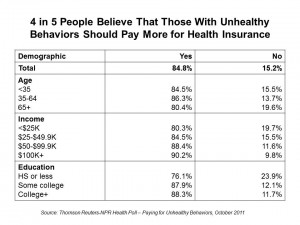 The health status of the American workforce is declining. Every year, unhealthy behaviors of the U.S. workforce cost employers $623 per employee annually, according to the Thomson Reuters Workforce Wellness Index. People point to smoking, obesity and stress as the 3 most important factors impacting health costs.
The health status of the American workforce is declining. Every year, unhealthy behaviors of the U.S. workforce cost employers $623 per employee annually, according to the Thomson Reuters Workforce Wellness Index. People point to smoking, obesity and stress as the 3 most important factors impacting health costs.
Thomson Reuters and NPR polled over 3,000 Americans on their health behaviors, utilization and costs of health care, publishing their results in a summary, Paying for Unhealthy Behaviors in October 2011.
4 in 5 overall — and 9 in 10 of those with over $50,000 annual income — believe that people with healthy behaviors should receive a discount on insurance premiums. Most people also believe that smokers should pay more for health insurance than non-smokers.
However, when it comes to overweight and obesity, there are mixed feelings among U.S. health citizens. Only 31% of people say overweight or obese people should pay more for health insurance.
People with greater education and income are more bullish about those with unhealthy behaviors paying more for health insurance premiums.
Scott Hensley’s take on the poll for NPR is here.
The survey polled 3,012 U.S. adults in September 2011, drawn from Thomson Reuters PULSE Healthcare Survey which annually collects information from over 100,000 U.S. households.
Health Populi’s Hot Points: Smoking is an epidemic among the poor in America, based on this poll: in the past 12 months, 32% of people with under $25K annual income smoked, compared with 19% of people across all income groups. 32% of people with high school education or less also smoke; only 10% of college grads smoked in the past year and only 6% of people with over $100K annual income smoked.
I’ve been spending a lot of time on the issue of workplace wellness in the past year. Given that most U.S. health citizens receive health insurance from employers, and in the “jobless recovery” the vast majority of people feel job-locked, there is less churn in employee populations. Employers are re-visiting what workplace wellness means, and are investing in new and targeted programs for improving the health habits and outcomes for their workers.
“A culture of health” is permeating pioneering employers who are looking more at value-based benefits that are artfully designed to nudge workers and dependents toward healthier behaviors, especially for movement (with an eye on overweight and obesity) and reducing BMIs. Smoking cessation continues to be a priority, as well as getting workers to engage in health promotion and disease prevention. The adoption of health portals in corporate intranets as well as a growing use of social media are underpinning these programs. Health challenges are successfully used in more companies, who are engaging wellness companies such as Limeade and ShapeUp that offer innovative and engaging platforms to move the needle on worker health. Safeway, the retailer and a longtime innovator in corporate wellness, engages employees online through their AisleOne health portal that provides workers a dashboard to help people track their biometrics, health actions, and incentives earned, along with personalized health plan information.
Employers will continue to provide health insurance looking to 2015, based on a sound analysis from the Urban Institute and Robert Wood Johnson Foundation published in October 2011. Reducing health costs is a team sport, and as long as the U.S. health insurance financing system is employer-based, that team is a joint prospect between the workplace and the worker.




 Interviewed live on BNN Bloomberg (Canada) on the market for GLP-1 drugs for weight loss and their impact on both the health care system and consumer goods and services -- notably, food, nutrition, retail health, gyms, and other sectors.
Interviewed live on BNN Bloomberg (Canada) on the market for GLP-1 drugs for weight loss and their impact on both the health care system and consumer goods and services -- notably, food, nutrition, retail health, gyms, and other sectors. Thank you, Feedspot, for
Thank you, Feedspot, for  As you may know, I have been splitting work- and living-time between the U.S. and the E.U., most recently living in and working from Brussels. In the month of September 2024, I'll be splitting time between London and other parts of the U.K., and Italy where I'll be working with clients on consumer health, self-care and home care focused on food-as-medicine, digital health, business and scenario planning for the future...
As you may know, I have been splitting work- and living-time between the U.S. and the E.U., most recently living in and working from Brussels. In the month of September 2024, I'll be splitting time between London and other parts of the U.K., and Italy where I'll be working with clients on consumer health, self-care and home care focused on food-as-medicine, digital health, business and scenario planning for the future...